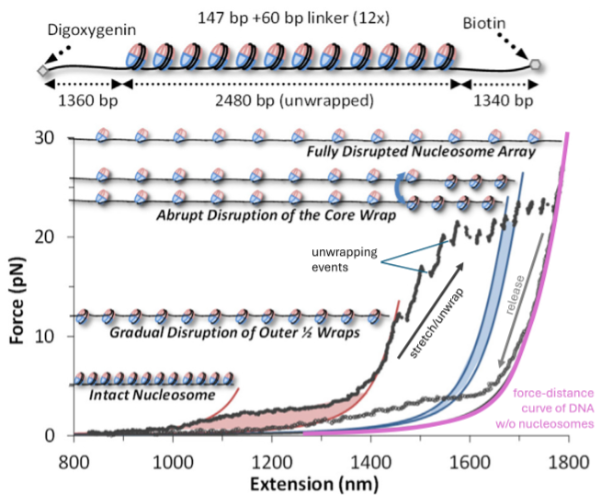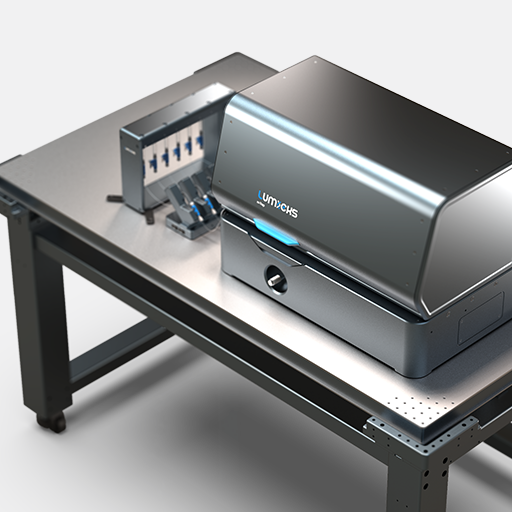
Mechanistic details of SMC complex functioning are still elusive?
Quantify SMC activity, conformation and interactions at the molecular level
The direct accessibility of binding rates and localization of SMC complexes on DNA and the ability to quickly change buffer conditions delivers key insights into the molecular mechanism of interaction.
With this method, the labs of Johannes Stigler (LMU Munich), Luis Aragon (MRC-IMS, London), and Shixin Liu (The Rockefeller University, NY) were able to identify unique binding and mobility behavior of SMC5/6 on ss- vs ds-DNA and could identify DNA fork structures as preferred binding location, emphasizing SMCs’ critical role in DNA replication and repair (see figure).
The real-time single-molecule imaging capabilities of the C-Trap also enabled Frank Uhlmann (The Francis Crick Institute, London) and his collaborators to directly observe condensin interacting with multiple dsDNA molecules, a mechanism that had earlier been identified for cohesin using a similar C-Trap assay.
In summary, dynamic single-molecule (DSM) microscopy is key to quantifying
- binding rates and location of SMC complexes on different DNA structures
- dynamic movement of SMC complexes on DNA and looping/cross-linking activity
- influence of additional factors (ATP, small molecules, other DNA-binding proteins) on SMC kinetics and dynamics
Use the force: By applying tension on cohesin-looped DNA, Luis Aragon and collaborators were able to quantify loop size as well as mechanical stability of the cohesin-mediated cross-links.
Furthermore, tension can also be directly applied to SMC complexes (or subunits) to quantify their conformational dynamics under force. By doing so, Johannes Stigler and colleagues identified structures and intermediate states in the coiled-coil region of SMCs that are critical for dynamic folding of the complex. For more details on the assay, see our protein folding page.
- Chang et al. Nature Communications (2022)
- Tanasie et al. Cell Reports (2022)
- Gutierrez-Escribano et al. Science Advances (2019)
- Tang et al Molecular Cell (2023)
- Freitag et al. Biophysical Journal (2022)
A Applying force do double-stranded DNA (dsDNA) exposes single-stranded DNA (ssDNA) around nick sites. RPA (green) selectively binds to those ssDNA regions. Smc5/6 (purple) binds to different regions of the DNA molecule (white arrowheads).
B 2D scan (left) and kymograph (right) binding to ssDNA-dsDNA hybrids. Complexes in ssDNA regions are static (blue arrowheads) while those in dsDNA regions are mobile (red arrowheads).
Figure adapted from Tanasie et al. Cell reports (2022)
Learn how DSM helped reveal details of the bacterial DNA condensation system ParAB
Data on remodeler dynamics is often indirect?
Follow chromatin remodeler activity in real-time
The single-molecule fluorescence imaging module of the C-Trap is designed to follow the dynamic movement of chromatin remodelers on DNA, also in the presence of nucleosomes or other structuring elements.
Multi-color imaging enables the tracking of different species of proteins involved in the process and gives access to quantitative, real-time information on
- binding kinetics and location of chromatin remodelers, histone chaperones, and other components
- dynamic behavior of nucleosome remodelers on DNA, e.g. sliding and diffusion
- colocalization of remodelers with nucleosomes, nucleosome transport, histone eviction
The groups of Taekjip Ha (Harvard University), Carl Wu (Johns Hopkins University Baltimore) and Shixin Liu (The Rockefeller University) have extensively used LUMICKS’ C-Trap to unravel details of remodeler target search and to discover hitherto unknown nucleosome remodeling capabilities of origin recognition complexes (ORCs), respectively.
Use the force: The optical traps of the C-Trap allow the application of well-defined mechanical tension on a single DNA molecule, mimicking the case of incomplete sister chromatid segregation or other mechanically challenging scenarios DNA is regularly facing.
By doing so, the groups of Erwin Petermann and Gijs Wuite (VU Amsterdam) in collaboration with Ian Hickson (University of Copenhagen) discovered an unknown role of the checkpoint helicase PICH: On DNA under tension, PICH shows nucleosome unwrapping and histone transporting activities, as directly observed with correlative dynamic single-molecule microscopy (see figure).
- Kim et al. eLife (2024)
- Li et al. PNAS (2022)
- Spakman et al. Nature Communications (2022)
Learn more about the study by Kim et al. on chromatin remodeler dynamics
Kymograph showing PICH-eGFP (green) and Atto647N labelled histones on DNA under tension (12.5 pN). A PICH-eGFP dimer initiates histone sliding at the instant of collision (white arrow) with the Atto-647N labelled histones.
Top: PICH channel (green)
Center: Histone channel (red)
Bottom: merge
Figure adapted from Spakman et al. Nature Communications (2022)
The accessibility of nucleosomal DNA is difficult to measure?
Use the force: Quantify nucleosome stability and cross-linking
By tethering arrays of nucleosomes between two optical traps, you gain access to quantitative information about the mechanical stability of individual nucleosomes as well as possible cross-linking interactions.
Additional factors like histone-modifying enzymes or nucleosome cross-linkers are quickly added via the integrated microfluidics and their interaction with the DNA/nucleosomes can be observed in real-time with single-molecule fluorescence microscopy.
The effects these factors have on nucleosome stability and cross-linking can be directly assessed by increasing the tension on the DNA substrate (see figure): Depending on the modification, the accessibility of DNA can be increased (destabilization, lower force required) or decreased (stabilization, higher force required).
In summary, with the dynamic single-molecule (DSM) approach you gain quantitative access to the
- location, duration and sequential order of modifier-nucleosome interactions
- mechanical stability of native and modified nucleosomes
- strength of nucleosome-nucleosome interactions mediated by cross-linking factors
Amongst other labs, the groups of Mark Williams (Northeastern University Boston) and Shixin Liu (The Rockefeller University New York) used this method successfully to unravel the impact of histone chaperones on nucleosome (dis)assembly, and Polycomb complex-mediated nucleosome cross-linking, respectively.
- McCauley et al. Cell Reports (2022)
- Leicher et al. PNAS (2020)
Top: Schematic representation of the molecular construct: a series of 12 3 207-bp Widom 601 positioning sequences flanked by two tagged handles, each labeled by digoxygenin/biotin tags for bead attachment
Bottom: Cycles of array extension/release disrupt nucleosomes in distinct stages that are only partially reversible upon release. Polymer models (solid lines) bracket outer wrap release (red), a single inner wrap disruption (blue), and the final full DNA (magenta). Shaded regions denote work done during unwrapping. Release partially restores wrapping.
Figure adapted from McCauley et al. Cell Reports (2022)







